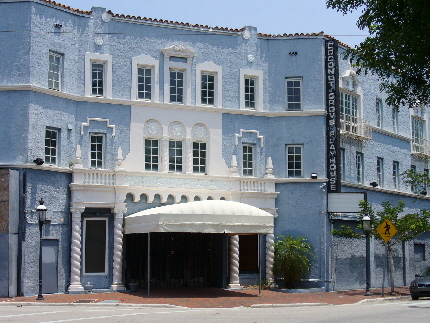 By Bill Hirschman
By Bill Hirschman
The curtain is not expected to rise on the first production at the “new” Coconut Grove Playhouse for five years, Miami-Dade County documents indicate. That’s if everything goes smoothly.
But work on the project has begun in earnest this month. The county is in the process of hiring an architect, and GableStage, which will operate the theater, has hired a consultant.
A rough estimated schedule for the project on the county’s website called “milestones” cites construction beginning Oct. 1, 2017 and it estimates that work will finish Sept. 30, 2019, although that likely includes a period when the building is open but touchups and minor changes are being made.
Prior to construction, the design phase – including soliciting public input on the fate of the existing 1926 landmark façade – will also be complex, as sketched out in documents.
The opening could occur sooner; that’s the expectation of Joseph Adler, producing artistic director of GableStage, the company joining the county and Florida International University to create a major regional theater and educational institution.
Adler wrote this week that he “didn’t think any of the projections for how long things will take are realistic at this point. I’m hoping we can do a lot better.”
But the project conceivably could be sidetracked even longer by unforeseen bid protests, court action, community discord and political disagreements, said Alex Peraza, a construction project manager with the county.
Michael Spring, who has shepherded the project as director of the Miami-Dade County Department of Cultural Affairs, expects the whole process to be complicated. “It won’t be elegant, but hopefully the result will be elegant,” he said in January.
Whether or not the opening comes sooner rather than later, GableStage is already in the planning phase. The theater signed a contract this month with AMS Planning & Research, a national firm specializing in arts and entertainment venues. AMS has advised county officials for 20 years on developing the arts in the region, including advice directly tied to the Adrienne Arsht Center and the South Miami-Dade Cultural Arts Center.
“This demonstrates that we are not standing still,” Adler said Thursday.
AMS staffers plan to work from about mid-summer to mid-fall, helping GableStage identify its goals, wants and needs in preparation for dealing with the main architect to be hired by the county, said AMS Director Katie Oman.
Further, late last year, as GableStage worked on the international production of Antony and Cleopatra, Adler spoke of the need to expand the board of directors and ramp up the theater’s infrastructure to handle challenges such as broader fund-raising from new sources and donors. Despite its reputation for consistent quality, GableStage has operated for years with a tiny staff and compact board. It now has an operating budget of about $1.2 million – less than half of what is initially expected to be needed at the Playhouse.
Adler is confident about the future of the Playhouse project, and hopes that the time it takes to open the building will not discourage potential donors and new board members. He said he is encouraged that his core supporters remain loyal. Subscriptions are coming in for next season even though the renewal letter lists no dates and cites only two potential titles: the 2013 Off-Broadway dark comedy Bad Jews, and Miamian Tarell Alvin McCraney’s Choir Boy, which was produced in July at Manhattan Theater Club and in London in 2012.
Adler understands the county’s caution about the estimated schedule. The new Perez Art Museum Miami was constructed “in no time at all,” he said, but last month the private Patricia and Phillip Frost Museum of Science fired the firm overseeing construction of a new building in downtown Miami being financed with county bond money.
A further example of unexpected problems: Strategic Properties and its founder Henry Pino began last month to try to put a lien on the Playhouse property for about $350,000, Spring said. The firm lent money to the Playhouse’s old board of directors years ago to develop the property, but may have been spent on operating expenses like payroll, Spring said. The Miami Herald reported in 2012 that county Mayor Carlos Gimenez had reached an agreement with Pino. Spring said last month that the debt cannot be collected now because all such claims were invalidated when the state took over the property in 2012 before giving it to the county early this year.
Meanwhile, the county machinery is churning as well. Proposals were received Friday afternoon from nine companies that want to serve as architect, consultant and construction overseer. The companies are umbrellas representing other firms to be named later since the county asked proposers to have partners specializing in such facets as theater design.
Those companies are all well-known firms based in Miami-Dade County, most with expertise in arts venues, historic preservation or both,. They were Arquitechtonica, which worked on the newly-opened South Miami-Dade Cultural Arts Center, Zyscovich, BEA Architects, R.J. Heisenbottle Architects, MC Harry Associates, Rodriquez and Quiroga, R.E. Chisholm Architects, Wilson Butler Architects, and Bermello Adjami and Partners. Details of the proposals were not available Friday evening because the offers were simply logged in.
The architect selection process is planned to go like this, county documents indicate:
—-A committee appointed by the mayor will evaluate the architects’ applications (some requiring an entire box) in a two-tier evaluation that includes meetings in June and July. The committee’s eventual recommendation goes to the Gimenez who then decides whether to pass it to the county commission for its approval. That process could take 6 to 8 months.
—- The architects’ initial work, including holding public hearings, conducting studies and finally drawing up plans, could take 1 1/2 to 2 years.
—–A similar process would be used to select the builder who would be supervised by the architect.
—–Construction is estimated to last 279 days.
Among the key issues that will remain unknown for some time is the fate of the 1926 building. The City of Miami gave it “historic preservation status” in 2005 in recognition of its representation of a Spanish Rococo style of architecture favored in Miami’s youth. That means it cannot be altered or torn down without city approval.
The charge to the architect/consultants includes developing a long-range master plan for the property. Deciding how the original edifice is to be used — renovated into a new theater, restored, razed, ignored — is part of the architect’s job description and will involve public input.
A key element will be to assess the physical condition of the old building.
Unofficial reports from some people who have been inside have been inconclusive. But a cross-community study in 2008 found, “The Coconut Grove Playhouse is in a state of functional disrepair: although the building has recently functioned as a theatre, it can hardly be considered to be in acceptable conditions.” It cites mold, leaks, crumbling plaster, uneven floors, damaged seats, doors that do not close and many code violations.
The architects are charged to consider all past studies and documents such as the City of Miami’s historic preservation status report, that 2008 community study led by the University of Miami in 2008 and a building plan developed by a consultant the same year.
Various county documents “envision” at least a 300- to 600-seat theater that many observers expect would be a free-standing building on the current parking lot, with space for college classes, plus a parking structure. Documents also envision the possibility of retail development and even a second larger theater – which could only be built within or replacing the historic façade.
The Playhouse has been closed since 2006 – its 50th anniversary season — when an estimated $4 million in debts caused its non-profit board to shutter operations. That invalidated the Playhouse’s lease with the state, which had taken ownership of the property in 1980.
For years, the county has been trying to develop a national-class regional theater for the site as part of its vision of Miami-Dade as an international cultural hub. It had raised $20 million through bond issues already earmarked for the project. But protracted dealings with creditors persisted to reduce $3.5 million in open claims.
Starting out as a movie theater in 1926, the three-story Spanish Rococo building on the City of Miami’s list of historical site has played a major role in Florida cultural history. The edifice on the southwest corner of the Coconut Grove business/entertainment district has been repeatedly remodeled under several ownerships while becoming one of the nation’s leading regional theaters that emerged after World War II. Producers like Zev Buffman, Robert Kantor, Jose Ferrer and, after 1985, Arnold Mittelman mounted their own shows, hosted national tours and even provided a home for works being developed for Broadway.
The shows and the performers reflected a time when fading stars and supporting actors in film and television were able to headline major stage productions that they would never have the chance to attempt in New York. Some were triumphs and many were flops. Some were unadventurous fare; others reflected the latest thought-provoking hit from Broadway.
Among the legendary productions was the first American version of Waiting For Godot, starring Tom Ewell and Bert Lahr, an evening that left many playgoers confused because it wasn’t the comedy those stars were usually seen in.







 A PaperStreet Web Design
A PaperStreet Web Design
